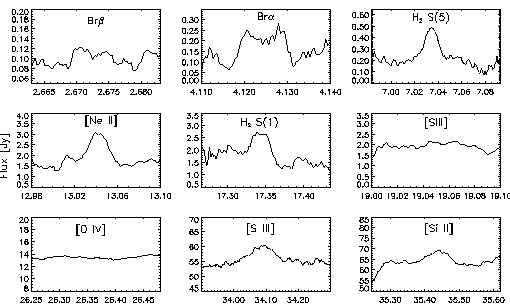Next: The IR spectrum of Up: ISO Info no. 10 Previous: List of successful proposals
SWS probes the power source of ultraluminous galaxies
It has been known for some time that Ultraluminous infrared galaxies (ULIRGs) result from collisions and merging of galaxies, but the cause of the high luminosity remained unknown. Optical and near-infrared observations had been unable to discriminate between bursts of star formation, or a central black hole `fed' with large amounts of matter.
The major difficulty in solving this puzzle are the huge amounts of dust hiding the centers of these galaxies from our direct view, absorbing optical radiation and re-emitting it as infrared radiation. All that could be observed until recently is a thin layer at the surface of the galaxy seen in visible light, and the infrared re-radiation by warm dust, which however tells very little about how the dust is actually heated. With the ISO -SWS, it is possible to observe at wavelengths where the absorption is much less severe, penetrating the dust clouds enshrouding the centers of galaxies, and to look for characteristic emission line signatures of the ultimate energy source. That SWS spectra provide such characteristic signatures is seen in galaxies with a well known energy source: for example, only galaxies powered by a central AGN show strong emission of highly ionized Neon and Oxygen.

New light is shed on Arp 220, the closest of the enigmatic ULIRGs, by the SWS spectra (see figure 1). Among the spectral lines detected for the first time are those of molecular hydrogen, which reveal that the optical-UV radiation heats much of the dense molecular gas to surprisingly high temperatures. The biggest excitement however was created by the search for the specific signatures of the power source: while lines typical for starbursts, such as singly ionized Neon [Ne II], are clearly seen, there is no trace of the signposts for a central black hole powerhouse, such as triply ionized Oxygen [O IV] or four times ionized Neon [Ne V]. This is the first time we can prove that most if not all of the luminosity in one of the ultraluminous infrared galaxies comes from star formation. To understand how and for how long such vigorous star formation can occur in these galaxies is now one of the most interesting questions to be pursued.
The SWS spectrum of Arp 220 can be compared with those of M82 (powered by star formation) and Circinus (powered by a central black hole), shown in figure 2. The spectrum of Arp 220 shows no emission lines indicative of being powered by a central black hole.
For more information see http://www.mpe-garching.mpg.de/iso/press/press001.php

Next: The IR spectrum of Up: ISO Info no. 10 Previous: List of successful proposals
Tue Jan 7 17:47:45 MET 1997